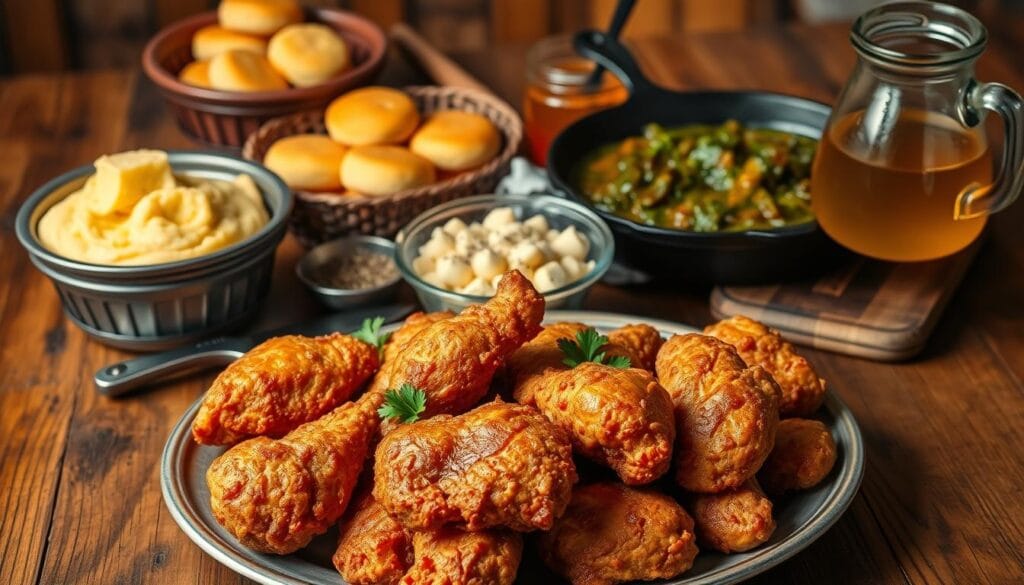Serves: 6 | Prep Time: 15 mins | Cook Time: 1 hr
There’s something magical about soul food — it’s comfort you can taste. This Soul Food Smothered Chicken recipe is like a warm hug on a plate. Crispy, golden-brown chicken simmers in a rich, velvety gravy until it’s fall-off-the-bone tender. Perfect for Sunday dinner, family gatherings, or meal prep, this dish celebrates Southern heritage in every bite.
Why You’ll Love This Recipe
- Feeds a crowd: Serves six with generous portions.
- True Southern comfort: Crispy chicken + creamy homemade gravy = perfection.
- Easy & approachable: Simple ingredients, clear steps, and under an hour of cook time.
- Heritage-inspired: A recipe that honors generations of Southern cooking.
- Meal-prep friendly: Stores beautifully and tastes even better the next day.
The Heart of Southern Cooking
Southern comfort food is more than just dinner — it’s history and hospitality in a single dish. This recipe combines:
- Golden crust: Achieved with seasoned flour and cast-iron heat.
- Caramelized onions: The base of any great smothered chicken.
- Velvety gravy: Rich, creamy, and perfect over rice or mashed potatoes.
“Plating is the final seasoning. Let each element shine while inviting the eye to feast first.”
Ingredients You’ll Need
| Ingredient | Amount | Purpose |
|---|---|---|
| Bone-in, skin-on chicken thighs & drumsticks | 6–8 pieces | Juicy, flavorful protein |
| All-purpose flour | 1 cup | Crispy coating & thickens gravy |
| Garlic powder | 2 tsp | Savory flavor |
| Paprika | 1 tsp | Warm, smoky depth |
| Black pepper | ½ tsp | Cuts through richness |
| Salt | 1 tsp | Enhances flavor |
| Yellow onions | 2 medium, sliced | Sweetness & aromatic base |
| Fresh garlic | 4 cloves, minced | Flavor boost |
| Cooking oil | ¼ cup | For browning |
| Chicken broth | 3 cups | Base for gravy |
Essential Tools
- Cast-iron skillet: Retains heat for perfect searing.
- Tongs & whisk: For flipping chicken and smoothing gravy.
- Mixing bowls & paper towels: For prep and coating.
Step-by-Step Instructions
1. Prep & Season
- Pat chicken dry with paper towels.
- Mix flour, garlic powder, paprika, salt, and pepper in a shallow dish.
- Dredge chicken until fully coated. Shake off excess and let rest for 5 minutes to help coating stick.
2. Brown the Chicken
- Heat oil in a cast-iron skillet over medium-high until shimmering.
- Arrange chicken skin-side down, without crowding.
- Brown for 6–8 minutes per side until golden and crisp. Remove chicken and set aside.
3. Build the Gravy
- Add onions and garlic to the pan drippings. Sauté for 4 minutes until fragrant.
- Sprinkle flour into skillet, whisking to make a roux. Cook for 2 minutes.
- Slowly add broth, scraping up brown bits. Simmer until thickened.
4. Simmer to Perfection
- Return chicken to skillet, spooning gravy over each piece.
- Cover and simmer for 35 minutes.
- Uncover and cook 10 minutes more to thicken gravy.
Serve hot over mashed potatoes, rice, or with cornbread to soak up every drop.
Pro Tips for Success
- Don’t skip patting chicken dry: It ensures a crispy crust.
- Work in batches: Crowding the pan causes steaming, not browning.
- Taste as you go: Adjust seasoning before simmering for best flavor.
- Use high-smoke-point oil: Peanut or avocado oil works best for frying.

Variations
- Spicy Kick: Swap paprika for smoked chipotle powder.
- Herb-Infused: Add fresh thyme or rosemary to the gravy.
- Lightened-Up: Use boneless thighs and reduce simmer time by 10 minutes.
Serving Suggestions
Pair this dish with:
- Creamy mashed potatoes or buttery grits
- Collard greens or green beans for freshness
- Golden cornbread or buttermilk biscuits
Storage & Meal Prep
- Fridge: Store leftovers in airtight containers for up to 3 days.
- Freezer: Freeze in portions for up to 3 months. Thaw overnight in fridge.
- Reheat: Simmer gently on the stove with a splash of broth to keep meat juicy.
Learn More About Southern Cooking
Want more cozy Southern recipes? Try our Best Chicken Recipes Collection for even more dinner inspiration.
For a deep dive into the history of Southern food, check out Southern Foodways Alliance — they explore the culture, history, and people behind these iconic dishes
- USDA Chicken Breast Nutrition: https://fdc.nal.usda.gov/fdc-app.html#/food-details/171705/nutrients
- National Cancer Institute on Broccoli Benefits: https://www.cancer.gov/about-cancer/causes-prevention/risk/diet/cruciferous-vegetables-fact-sheet
- Safe Grilling Tips: https://www.fsis.usda.gov/food-safety/safe-food-handling-and-preparation/grilling-safety
Looking to explore more healthy chicken bowls, low-carb chicken recipes, or broccoli recipes for dinner? Head over to www.whatfordinner.com for expert-crafted, nutrition-focused meal ideas.

j54vhi
w6j8s4
9bz19f
I like this web site very much, Its a real nice situation to read and incur info .
This is really interesting, You are a very skilled blogger. I’ve joined your feed and look forward to seeking more of your excellent post. Also, I’ve shared your website in my social networks!
Greetings! Very helpful advice on this article! It is the little changes that make the biggest changes. Thanks a lot for sharing!
90b7ft
hfqlys
3pzwg5
nmhrfa
**mind vault**
mind vault is a premium cognitive support formula created for adults 45+. It’s thoughtfully designed to help maintain clear thinking